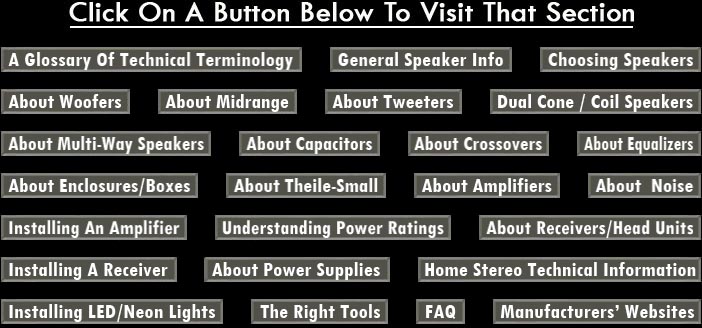


Octave
In audio, the interval between any two frequencies having a ratio of 2 to 1. One octave up from 100 Hz is 200 Hz, where one octave down from 100 Hz is 50 Hz. A harmonic is a doubling (2nd harmonic), tripling (3rd harmonic), quadrupling (4th Harmonic... etc) of a fundamental frequency. Musical instruments (with the exception of electronic synthesizers) do not create pure tones. The fundamental (main frequency) is combined with its harmonics at various levels to create the sonic signature, or timbre of that instrument.
Ohm
The measurement of electrical resistance and system impedance. It is a measure of the degree to which electrons are limited in both velocity and quantity in passing through a circuit. In Impedance measurements, this takes into account, the mechanical resistance inherent in the motion of transducers. The standard is usually 4 ohms for car audio and 8 ohms for home and commercial audio. Some specialty woofers may be rated at 16 ohms.
Ohm's Law
The mathematical relationship between voltage, current, and resistance. It is named after George Ohm, it's discoverer. Ohm's law states that current volume in a conductor is directly proportional to the voltage flow across it and inversely proportional to its resistance. In general, this means that more voltage will produce more current, if resistance stays the same, but higher resistance will cause current to decrease if voltage stays the same. In mathmatical terms, V = I x R, where V is voltage, I is current, and R is resistance. Ohm's law is a description of electron behavior upon which virtually all understanding of electronics is based.
Omnidirectional
Literally, from all directions. In audio, microphones are said to be omnidirectional if they can detect sound with equal sensitivity from all directions. Speakers are omnidirectional if they produce sound pressure level that is the same without regard to the position of the listener vis a vis the axis of the driver or port; this tends to be the case with subwoofers and low frequency drivers. Low frequencies, in general, tend to be omni-directional, unlike high frequencies, where directionality increases with frequency.
On Axis
A listening experience which takes place with the ear precisely lined up with the central pressure axis of the emitter. Headphones are a normative example of this effect. Sitting directly in front of a speaker is another.
Op amp
(operational amplifier) An analog integrated circuit device having two opposite polarity inputs and one output; frequently used as a basic processing unit in the design of analog signal circuits.
Oscillator
A device which produces an alternating current or pulsating current or voltage at varying frequencies, electronically.
Output (Audio)
The high level (speaker) or line level (RCA) signals sent from one system component to another, or the high level signal from an amplifier to the system speakers.
Oversampling
A technique where each sample from a data converter is sampled more than once, i.e., oversampled. This multiplication of samples permits digital filtering of the signal, thus reducing the need for sharp analog filters to control unwanted frequencies created when sampling a signal of a frequency higher than half the sampling rate.
Overtone
Similar in concept to a harmonic. Overtones are sounds produced by an instrument (or sound source) that are higher in frequency than the fundamental frequency. They may or may not coincide with the frequencies of a harmonic series (harmonics), although they usually do. Harmonics are always musically related to a fundamental in that they are integer multiples of it. Overtones of a sound are often identical to its harmonics except the first overtone is considered the second harmonic because the first harmonic is the fundamental. Overtones are also sometimes called partials.















